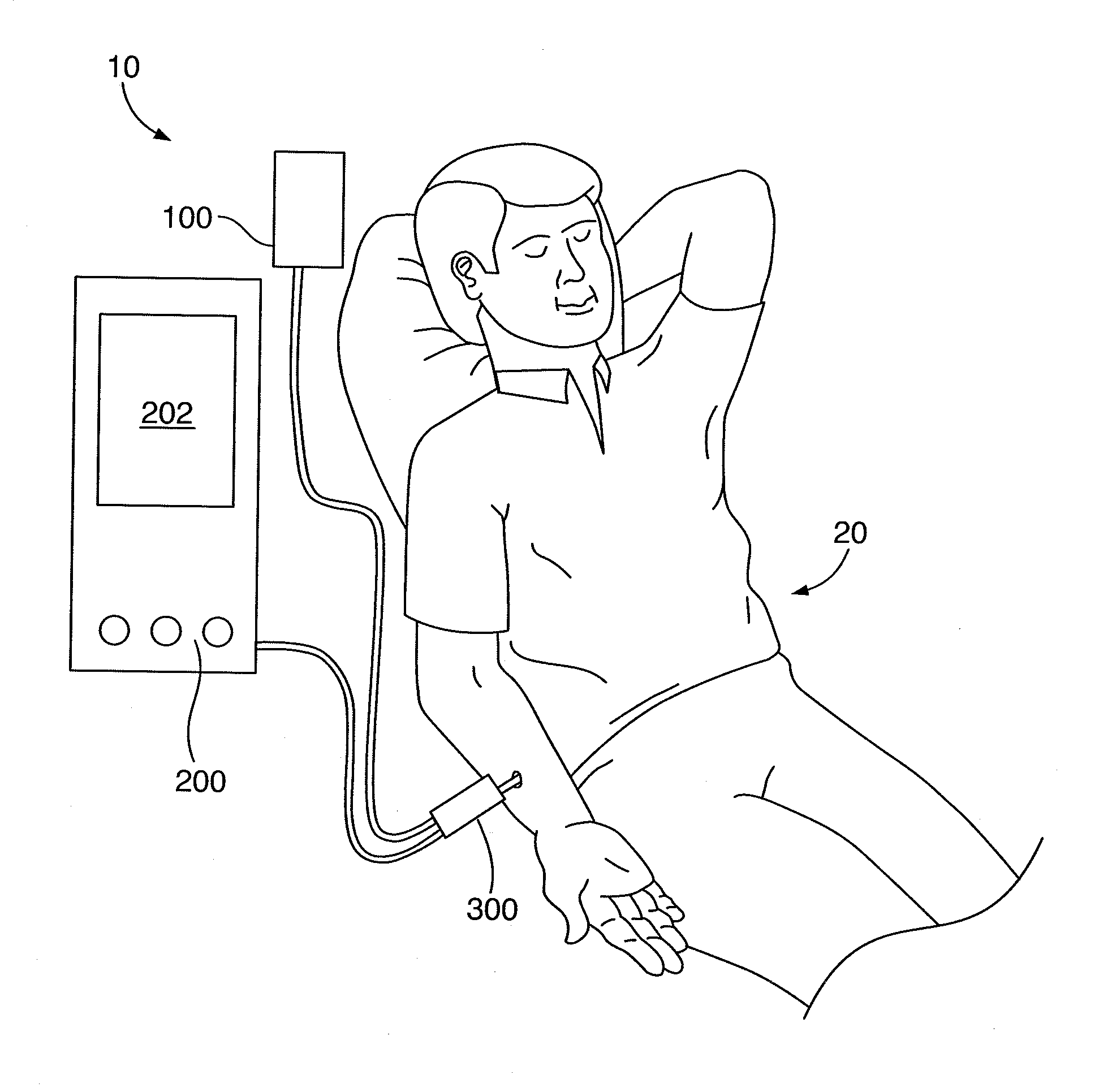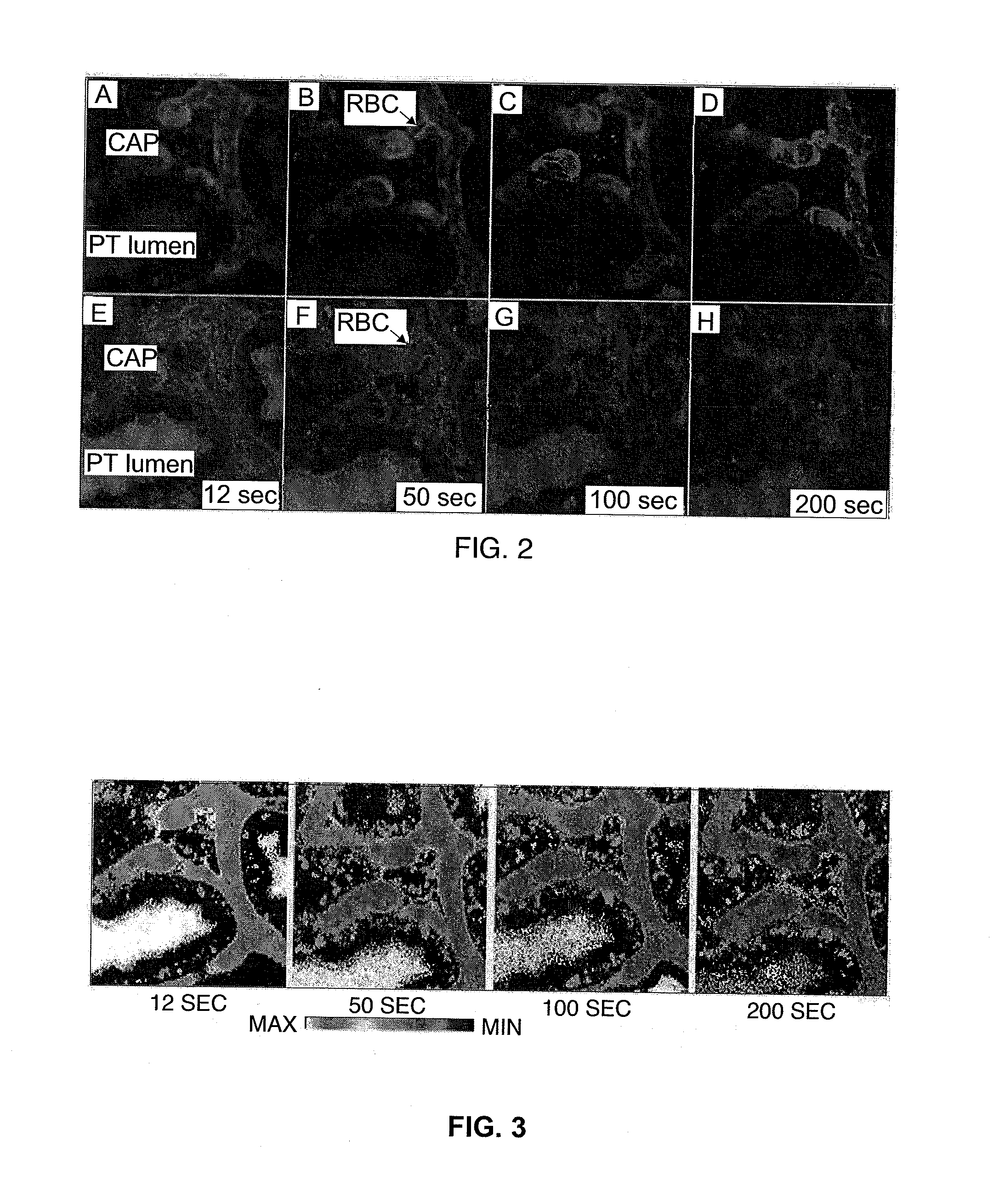Renal Function Analysis Method and Apparatus
a function analysis and renal function technology, applied in the field of medical methods and devices, can solve the problems of increased mortality rate, inability to reliably apply two approaches over the full range of gfr, and independent association of aki, so as to accurately quantify and track the degree of renal function, the effect of convenient operation and near real-time efficiency
- Summary
- Abstract
- Description
- Claims
- Application Information
AI Technical Summary
Benefits of technology
Problems solved by technology
Method used
Image
Examples
example 1
Measurement of GFR in Swine Using Fluorescence Ratiometric Analysis Method
[0142]The data obtained using the described optical device (also known as the fluorescence ratiometric analysis method herein) from a female Osawbaw swine weighing 29.5 kg are shown in FIG. 18. The anesthetized pig was administered 75 mg 5 kDa FITC-inulin and 75 mg 150 kDa Texas Red-dextran. The fluorescent data after the completion of the mixing in the vascular space following the bolus infusion are shown. FIG. 18A shows the normalized fluorescence time course for both small and large conjugates. While the signal from the large non-filterable dextran (red channel) remained stable over time, the signal of the filterable 5 kDa FITC-inulin (green channel) decreased rapidly initially indicating a combined inter-compartment movement (from the vascular space to the interstitial space) and kidney clearance, which was followed by a slower decay caused only by kidney clearance (from the vascular space). As a result, t...
example 2
Measurement of GFR in Dog Using the Fluorescence Ratiometric Analysis Method
[0143]Data from the dog study are shown in FIG. 19. The dog was administered 175 mg 5 kDa aminofluorescein-dextran and 75 mg 150 kDa 2-sulfohexamine rhodamine-dextran (2SHR-dextran). The higher noise in the data was caused by the movement during the data collection as the dog was not anesthetized. The plasma volume was determined to be 1720 ml. The GFR of the 33.0 kg dog was determined using three different methods. The value determined from the optical device was 4.49 ml / min / kg and the value obtained from iohexol analysis reported from Dr. Schwartz's laboratory was 4.50 ml / min / kg.
example 3
Corrleation of GFR Determined by Fluorescence Ratiometric Analysis Method and by the Iohexol Plasma Clearance Method in Gentamycin-Induced Acute Kidney Injury (AKI) Dogs
[0144]Five spayed female young adult hound-type mogrel dogs were confirmed to be in good health based on physical examination, complete blood count, blood chemistry analysis, urinalysis, urine protein-to-creatine ratio (UPC) and aerobic urine culture. Acute tubular necrosis was induced in the 5 dogs with IV gentamycin (10 mg / Kg IV q8 hours for 10 days; first day of injection was Day 0. Serum creatinine, blood urea nitrogen (BUN), urine specific gravity (USG), UPC and GFR via iohexal plasma clearance method and ratiometric fluorescence analysis method were determined on days 3, 6 and 9. All dogs were euthanized on day 9. Table 1 shows the serum creatinine and BUN concentrations, USG and UPC in the five dogs with gentamycin-induced AKI. Greater than 25% increases over baseline serum creatinine, reduced urine concentrat...
PUM
 Login to View More
Login to View More Abstract
Description
Claims
Application Information
 Login to View More
Login to View More - R&D
- Intellectual Property
- Life Sciences
- Materials
- Tech Scout
- Unparalleled Data Quality
- Higher Quality Content
- 60% Fewer Hallucinations
Browse by: Latest US Patents, China's latest patents, Technical Efficacy Thesaurus, Application Domain, Technology Topic, Popular Technical Reports.
© 2025 PatSnap. All rights reserved.Legal|Privacy policy|Modern Slavery Act Transparency Statement|Sitemap|About US| Contact US: help@patsnap.com



